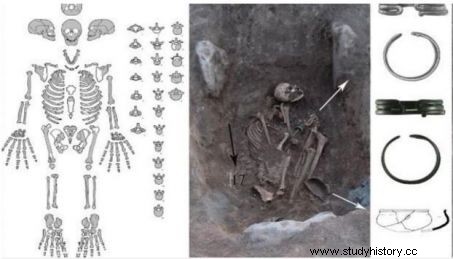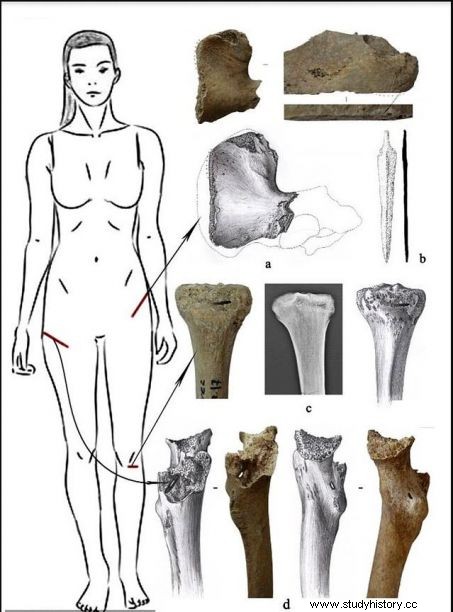The burial of a "warrior" woman could have been discovered in northern Armenia, as the osteological examination of a skeleton seems to indicate. A descendant of the legendary Amazons?

Achilles killing Penthesilea, queen of the Amazons (Greek vase from the 6th century BC)
Did a "warrior" woman die on the highlands of present-day Armenia more than 2,500 years ago? This is what researchers estimate in a study published in the International Journal of Osteoarcheology . Archaeologists, specializing in trauma related to the use of sharp weapons on human remains, analyzed a body unearthed in 2017 in the necropolis of Bover I in the province of Lori, in the north of the country. Their findings establish that this female skeleton exhibited "a wide range of traumatic injuries " as Forbes magazine reported of November 26, 2019. An arrowhead was still stuck in his left knee, three other weapon wounds possibly resulting in his death.

The burial of the "warrior woman" of Bover I, in Armenia. © Anahit Khudaverdyan / National Academy of Sciences of the Republic of Armenia.
A professional archer?
"His left hip and right femur bore slash marks, while one of the shins had been struck by a blade" , wrote the co-signatories of the article, led by Anahit Khudarverdyan, of the National Academy of Sciences of the Republic of Armenia. Additionally, "two of the ax and sword wounds suggest an attack by multiple assailants. Reason why we assume she died in action" , conclude the bioarchaeologists. The young woman, aged around twenty and identified in tomb 17 of the cemetery of Bover I, could thus have been part of the army of the kingdom of Urartu (or Ouraratou) (9th-6th century BC). ), a territory located in the Armenian Highlands around Lake Van. A particularly important development of his rib cage appears indeed typical "of a professional archer" according to the authors. Buried with finery, the deceased was undoubtedly a woman of high rank.
Did a "warrior" woman die on the highlands of present-day Armenia more than 2,500 years ago? This is what researchers estimate in a study published in the International Journal of Osteoarcheology . Archaeologists, specializing in trauma related to the use of sharp weapons on human remains, analyzed a body unearthed in 2017 in the necropolis of Bover I in the province of Lori, in the north of the country. Their findings establish that this female skeleton exhibited "a wide range of traumatic injuries " as Forbes magazine reported of November 26, 2019. An arrowhead was still stuck in his left knee, three other weapon wounds possibly resulting in his death.

The burial of the "warrior woman" of Bover I, in Armenia. © Anahit Khudaverdyan / National Academy of Sciences of the Republic of Armenia.
A professional archer?
"His left hip and right femur bore slash marks, while one of the shins had been struck by a blade" , wrote the co-signatories of the article, led by Anahit Khudarverdyan, of the National Academy of Sciences of the Republic of Armenia. Additionally, "two of the ax and sword wounds suggest an attack by multiple assailants. Reason why we assume she died in action" , conclude the bioarchaeologists. The young woman, in her twenties and identified in tomb 17 of the Bover I cemetery, could thus have been part of the army of the kingdom of Urartu (or Ouraratou) (9 e -6 e century BC. J.C), a territory located on the Armenian highlands around Lake Van. A particularly important development of his rib cage appears indeed typical "of a professional archer" according to the authors. Buried with finery, the deceased was undoubtedly a woman of high rank.

Location of weapon wounds noted on the skeleton of Bover 1 (Armenia). © Anahit Khudaverdyan / National Academy of Sciences of the Republic of Armenia.
"The myth of the Amazons stems from very real events"
This is not the first time that a female warrior's grave has been unearthed in these regions of Asia Minor."This burial is the second encountered in Armenia" , say the scientists. Since the 1970s, the steppes stretching from the Volga to the Urals have also yielded several Scythian and Sarmatian female tombs, filled with deposits of weapons, in particular arrowheads. In 2000, several of them were unearthed along the Don and Volga Rivers in Russia. In fact, the multiplication of these discoveries now attests beyond doubt to the existence of combatants in Antiquity, whether or not they are a reflection of the fabulous Amazons of the ancient poets, these female warriors described for the first time in the Illiad (8th century BC) and later by the Greek historian Herodotus (5th century BC) in his Book IV .
One of the best French specialists of the Scythian world, the archaeologist Véronique Schiltz, recently deceased, already specified in the pages of Sciences et Avenir in 2003 :"Among nomadic peoples, unlike sedentary societies, there was a great equality between the two sexes in the distribution of tasks. And the new discoveries confirm that the myth of the Amazons stems from very real events" . The existence of armed horsewomen, the Oiorpata (" killers of men") could thus have been brought from the hinterland to the Greek counters of the Black Sea and the Sea of Azov, then taken up by Greek authors, including Herodotus. Women's tombs in context have been discovered in recent decades. If they were not Amazons in the epic sense of the term, they were, on the other hand, women fighters.
Find out more: The Amazons , by Adrienne Mayor, Editions La Découverte, 2017
